Letter From The Philippines
We learned how American “best practices” and “standards” would translate to groups serving young people and families half a world away.
It’s about two in the morning, and we’re standing on a busy street corner in Quezon City, a part of Manila. We’ve been brought here by outreach workers from a small organization working to help teenage prostitutes create alternatives to lives that seem to us to be completely miserable.
Here an act of sex literally costs the same as a cup of coffee. It’s sweltering even at this time of night, and the whole scene is dark and loud and bleak. In between constant interruptions from car horns, pimps, and friends, 15-year-old girls tell us about the economics of their lives and the health issues they face. They are getting help from Kabalikat ng Pamilyang Pilipino Foundation, a local social service agency.
Kabalikat receives funds from the Consuelo Zobel Alger Foundation, our client. Consuelo is based in Hawaii and Manila, and has as its mission to improve the quality of life of disadvantaged children, women and families. Nearly 60 Philippine organizations receive a large part of their funding from Consuelo.
“Standards” As Management Tool
Consuelo’s CEO, Patti Lyons, is deeply committed to helping her grantees to be organizationally strong through the creation and adoption of standards.
These standards cover the full range of business domains and practices. Some are generic, relating to good governance and personnel. Others relate to specific nonprofit services, such as youth development or residential treatment. Ideally, in the process grantees come to have a far more sophisticated understanding of what good work is.
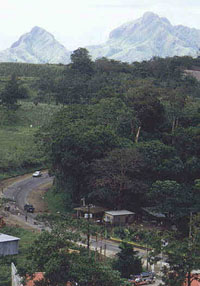
Volcanic formations seen from my room at the conference center at Lake Taal, Philippines
Consuelo’s intentions reflect a subtle, yet growing trend. While other foundations may not go as deep as Consuelo in promoting best practices, funders in the US are certainly more involved than ever before in wanting to know how value is being delivered by the organizations they are funding.
Three of us from the US were hired by Consuelo as consultants a couple years ago. Victoria Wagner is CEO of YouthCare in Seattle, an organization working for 30 years in the Pacific Northwest to provide a range of services to homeless and disadvantaged youth. Joe Costa is the CEO of Sunny Hills Children’s Garden, a residential treatment center north of San Francisco. As an independent consultant, I’m helping to coordinate the process.
Our deepest challenge is cultural. The US has been heavy-handed at many points in this century with the Philippines. Again and again we heard about the complicated relationship that the Philippine people have with America. While the Philippines were originally colonized by the Spanish, the US took over at the turn of the last century. The details are unimportant, but we’ve got to keep in mind some perceptions of injustice. We can’t be “The Americans who arrive with directives, mandates, and answers.” We’ll have to earn the trust of those we are working with, and can expect early ambivalence and skepticism.
But it’s a tightrope. On the one hand, we’re catalysts, allowing ideas and practices to “bubble up.” And, we can’t avoid the fact that we have beliefs about the value of standards and the best practices they embody. Above all, we are operating under this assumption: There is an emerging world management culture in which certain business and organizational practices transcend geography.
Consuelo’s Role
It’s hard to find an analogous situation in the US, and to imagine a foundation attempting to influence the behavior of its grantees to this extent implied by adoption of a full set of written standards. But Consuelo’s interests are nuanced.
First, while Consuelo does want its grantees to adopt standards, it wants this adoption to be accomplished with a sense of maximum ownership on the part of the grantees. The language of “compliance” and “enforcement” is not used. Instead, they talk of technical assistance,” “self study,” “capacity building” and “self assessment.”
Second, for most of its grantees, Consuelo is the main source of funding. There are not other funding bodies with competing standards. In fact, the foundation environment in the Philippines is characterized by relatively few private foundations, although there are a number of international non-governmental organizations.
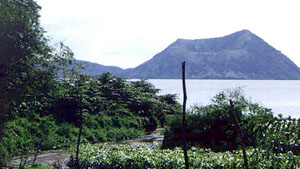
Taal Volcano is viewed as one of the most dangerous in the world by volcanologists
Pulling from a number of sources, including the work of the Council on Accreditation in New York City, we write a very early set of standards. Behind the scenes preparations involve working with the staff of the Consuelo foundation and its operating organization, the Children and Youth Foundation of the Philippines, to develop the draft standards to be taken to all the grantees.
We do this in two, year-long cycles that culminate in “Partner” meetings held in November 2000 and 2001. Organizational standards are taken up in 2000, service standards in 2001. The executive directors of 50 organizations participate in these multi-day meetings held in the Manila area.
We work hard to develop relationships. And it’s tough. Six p.m. in the US is 8:00 a.m. in the Philippines. International conference calls quickly become both frustrating and hilarious as clipped voices and delays create every kind of confusion and misunderstanding. Furthermore, the Philippines is a country of hundreds of islands, and we encounter challenges in creating the in-country planning process that might bring together representatives of different organizations during interim periods.
And as we head to the country at the end of 2001, meeting locations are changing and logistics are getting complicated as issues of terrorism emerge.
How to Get There
Over two years, we use a two-step process. Year one is an introduction of new standards. I state to the group, “While we believe these standards are good and are useful, please see them as illustrative, and for your discussion and modification. We want you to change them however you’d like.”
And we keep up the continual reminder: “The standards themselves are simply vehicles for you to talk about the specifics of how you know you are doing good work.”
Joe and Vicki present the drafts. Then, we divide the room into small groups, where people are free to delete, modify, and add to our work. They are guided by a set of group process methods and decision rules on how to get agreements.
These evolving edits move around into different configurations of people. It all culminates in a formal and fun presentation and hand-off back to the Consuelo foundation staff for editing and re-formulation.
Then a year later, there is review and assessment of the re-written, edited standards coming out of year #1. This time, there’s a ground rule: No changes are allowed! The work is to carefully prepare for implementation.
What About Cultural Differences?
Issues of culture definitely play their part. We notice a terrific intensity around issues of language. English is the formal language of business in the Philippines but not the language used day to day (that would be Tagalog). Rather than seeing language and meaning in flux, grantees have very hard beliefs about the “correct” meaning of many different words.
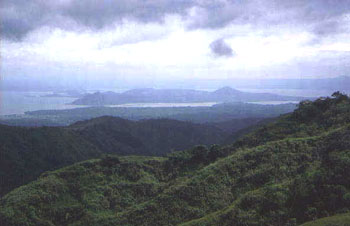
Looking down at the lake from which Taal Volcano erupted
For example, in one session, we addressed a particular standard about conducting cyclical needs assessments. A number of people made all sorts of negative statements that I first thought were disagreements with the concept. But after ten minutes, I realized that the concept was completely supported, but that the term “situation analysis” had to be substituted for “needs assessment.” A quick substitution was made, and we moved on.
We notice another striking dynamic. On one hand, there is real reticence on the part of most participants to talk and converse in the large group setting. Yet this is offset by a wonderful unself-consciousness in singing, dancing, and laughing. Early on, I recognize a recipe for meeting success-find a couple meeting participants who would be willing to introduce meeting sections with various sing-alongs, stretching, and chants. This works really well, and we create a lot of energy.
And, at one tired-feeling moment, I had everyone stand and walk outside to a high grassy spot. Imagine looking down from a high mountain ridge to the active Taal Volcano. Bring to mind 80 people who have almost immediately organized themselves into boisterous singing and dancing of traditional songs.
The Standards
What about the standards themselves? To illustrate, consider the category “Technical Education and Skills Development” with its 40 standards. Examples of very different standards include:
- The appropriate instructor-to-student ratios
- The degree to which there is a plan to place participants when a set of classes is completed
- Provision of training in skill areas currently desired by industry
- Maintenance of first aid tools and supplies on site
Remember that these standards are types of outcomes, and that any particular organization is achieving them or not to some degree. Each standard contains a four point scale-the rating indicators-by which compliance with the standard is evaluated.
So, within the standard for student-teacher ratios, a successful rating is one teacher to 30 students, reflecting a best practice emerging during the planning process itself. For this standard, the indicators range from consistent maintenance of this 30 to 1 ratio (a “four” score) to consistently exceeding it (a “one” score), with a couple gradations in between.
Rubber Meets Road
And it is within these indicators that the politics of the whole effort become clear to the grantees. Concerns emerge as we field questions within the sessions and in the hallways during breaks:
I hear one person say with some exasperation to another, “What I want to know is: Who is evaluating whether a standard is being met?”
Another puts it point blank to the whole group: “If we don’t meet all the standards do we at some point lose Foundation funding?”
Someone whispers to me apologetically, “Where am I going to get the money to document all these things you all seem to want?
We talk these questions over in the large group
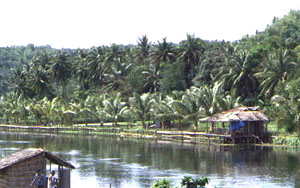
On the way to Lake Taal, which is located three hours by road from Manila
With final standards in hand, next steps involve a self-assessment by each organization. During these initial stages, power and authority remains with the grantees themselves. They had a role in developing the standards, and they will now conduct a self-study and assess themselves for each applicable standard.
The internal self study will identify areas of needed work, and will involve meetings with Consuelo foundation staff. Technical assistance and dollar resources will be available from the foundation.
Over time, the evaluation process will evolve towards “peer” reviewers. One of the deeper intentions behind the standards project is the creation of a collective sense across programs regarding good practice.
Also, during these early periods, there is a major, parallel capacity building process within the foundation itself. Staff are being trained to become increasingly skillful at assessing grantee performance on standards, and in providing variety of types of technical assistance in helping them to productively use the standards.
Consuelo is prepared for this work. The Foundation’s CEO, Patti Lyons, is tough on the need to address and implement the standards, but is flexible and softer with respect to the means to do so.
As realists, we note the cautions
During any particular period, good strategic management increasingly operates with attention to the few crucial issues needing attention. Agencies with a book of over 100 standards will fail if they are trying to implement simultaneous changes across multiple categories. Prioritization is needed, as is phasing and scheduling.
Second, and related, is the requirement that organizations operate within their available resources. Plans for change must be accurate about available resources. Even the self-assessment itself is expensive, involving different kinds of required documentation and analysis.
Third, if the standards constitute the template for the Consuelo foundation to know about the performance of its grantees, a substantial enhancement of it existing staff capacity will be needed. A number of organizations will simply not know how to achieve standards, and they will need some sophisticated technical assistance.
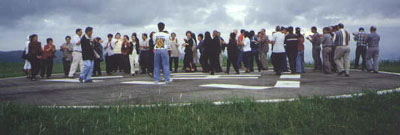
Conference attendees dance and sing at the conference center at Lake Taal, Philippines
We’ve thoroughly enjoyed our work, and depart with great appreciation for the talent and good spirit of both the grantees and foundation staff. We have a sense that the executive directors do see standards as best practices, and that they are excited to be a part of the effort. We also confirm our initial sense that there are universal practices that can help culturally diverse organizations – but only if these are presented in a tone of skillful and caring partnership.